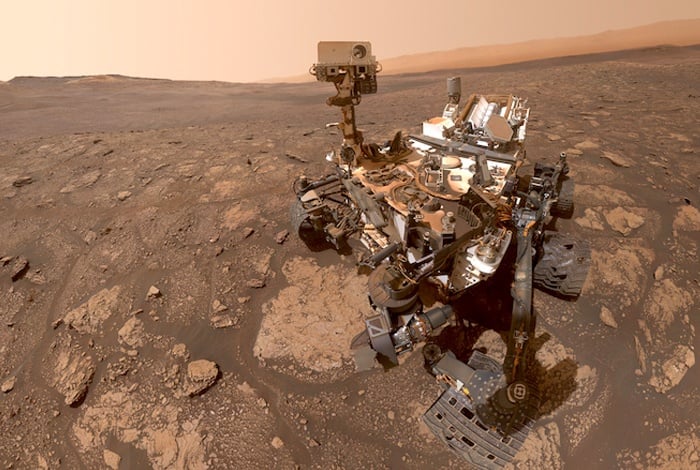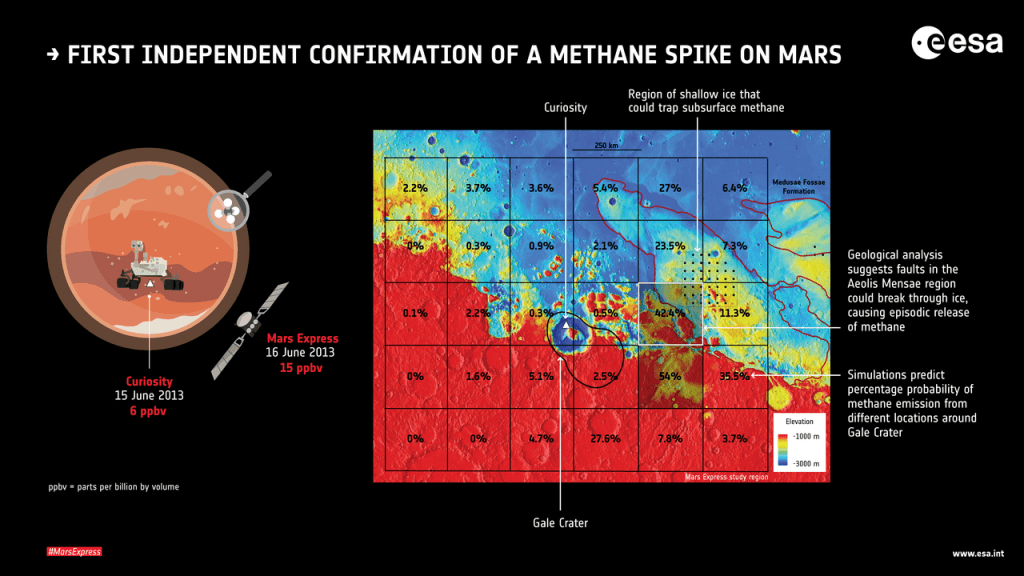One ongoing mystery on Mars is the sporadic detection of atmospheric methane. Since 1999 detections have been made by Earth-based observatories, orbital missions, and on the surface by the Curiosity Rover. However, other missions and observatories have not detected methane at all, and even when detected, the abundances appear to fluctuate seasonally or even daily.
So, where does this intermittent methane come from? A group of scientists have proposed an interesting theory: the methane is being sucked out of the ground by changes in pressure in the Martian atmosphere. The researchers simulated how methane moves underground on Mars through networks of underground fractures and found that seasonal changes can force the methane onto the surface for a short time.
In their paper, published in the Journal of Geophysical Research: Planets, the scientists say their simulations predict short-lived methane pulses prior to sunrise for Mars' upcoming northern summer period, which is a candidate time frame for Curiosity's next atmospheric sampling campaign.
"Our work suggests several key time windows for Curiosity to collect data," said John Ortiz, a graduate student at Los Alamos National Laboratory who led the research team. "We think these offer the best chance of constraining the timing of methane fluctuations, and (hopefully) down the line bringing us closer to understanding where it comes from on Mars."
The presence of methane (CH4) in the Martian atmosphere is of great interest to planetary scientists and exobiologists because it could indicate present or past microbial life. Or, it could also be related to nonbiological processes, such as volcanism or hydrothermal activity.
The problem with detecting methane is that it doesn't last long. Once released into the atmosphere, it can be quickly destroyed by natural atmospheric processes. Therefore, any methane detected in Mars' atmosphere means it must have been released recently, which only adds to the intrigue.
On Earth, most methane is produced by living creatures such as microorganisms in sedimentary strata, or in the guts of ruminants (cows, sheep, deer, etc.). For methane produced through abiotic or non-living processes, there is a high likelihood it could have been produced millions or even billions of years ago, lying trapped in underground rock formations.
But still, finding methane on Mars is a big deal because of the potential for biological sources, such as methanogenic microbes.
In 2004, the Mars Express Orbiter (MEO) detected methane in the Martian atmosphere. In 2013 and 2014 Curiosity detected spikes in methane in the atmosphere at Gale Crater. Interestingly, MEO detected a methane spike again, at the same location that Curiosity did, only one day later.
Ortiz and his team wanted to better understand Mars' methane levels, and used high-performance computing clusters to simulate how methane travels through networks of underground fractures, and then released into the atmosphere when driven by atmospheric pressure fluctuations. They also modeled how methane is adsorbed onto the pores of rocks, which is a temperature-dependent process that may contribute to the methane level fluctuations.
The team said their simulations predicted methane pulses from the ground surface into the atmosphere just before the Martian sunrise in the planet's northern summer season, which just recently ended. This corroborates previous rover data suggesting that methane levels fluctuated not only seasonally, but also daily. With these insights, the Curiosity rover team can figure out when and where to look for methane, which could aid in the rover's main goal, searching for signs of life.
"Understanding Mars' methane variations has been highlighted by NASA's Curiosity team as the next key step towards figuring out where it comes from," Ortiz said. "There are several challenges associated with meeting that goal, and a big one is knowing what time of a given sol (Martian day) is best for Curiosity to perform an atmospheric sampling experiment."
Paper: “Sub-diurnal methane variations on Mars driven by barometric pumping and planetary boundary layer evolution.” Journal of Geophysical Research: Planets. DOI: 10.1029/2023JE008043
LANL press release
 Universe Today
Universe Today

